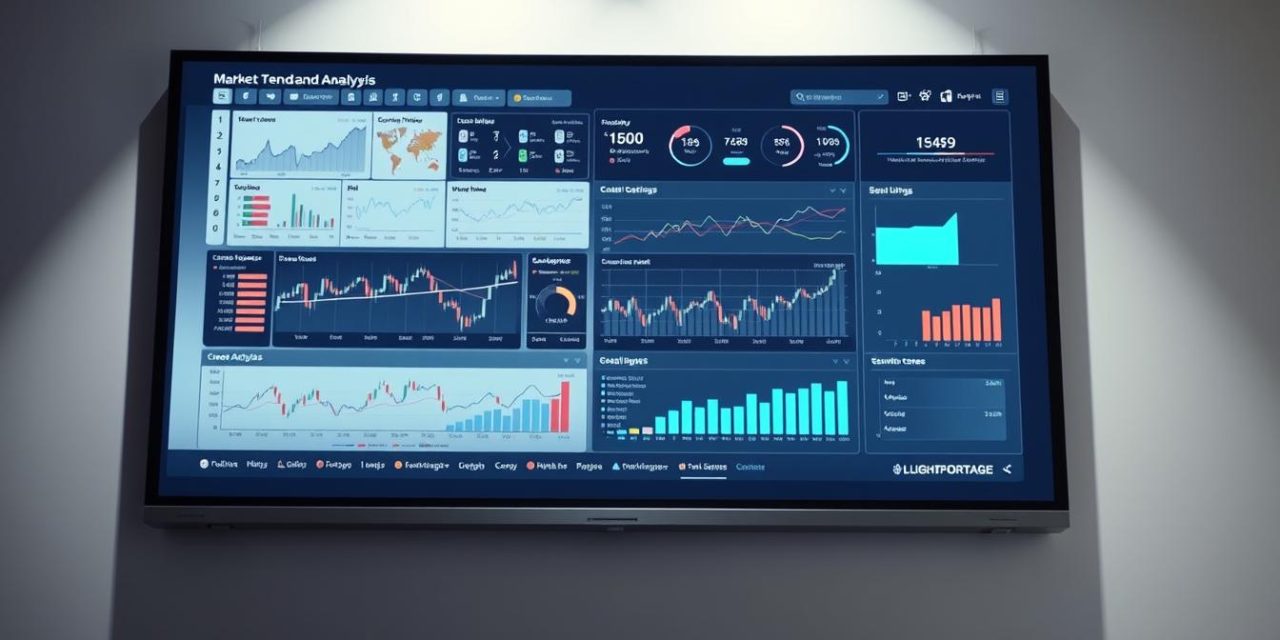Navigating the ever-changing landscape of market trends is crucial for independent professionals seeking stability and success in their careers. As an independent career, understanding the direction and momentum of the market can be the difference between thriving and merely surviving.
As we guide you through the complexities of trend analysis, you’ll gain the insights needed to make informed decisions that drive your business forward. Our goal is to empower you with the knowledge to identify emerging trends early, creating competitive advantages and opening new opportunities for your independent business.
Table of Contents
Key Takeaways
- Understand the fundamental principles of trend analysis and its application to independent careers.
- Learn how to identify emerging market trends to create competitive advantages.
- Discover actionable strategies for leveraging market trends to your advantage.
- Gain practical tools to make informed decisions based on market movements.
- Explore how trend analysis can be applied to various independent career paths.
Understanding Market Trends in Today’s Economy
The ability to navigate market trends is essential for independent professionals seeking to thrive in today’s competitive landscape. Understanding these trends allows investors and analysts to make more informed decisions when buying or selling financial assets.
Definition and Importance of Market Trends
Market trends refer to the direction in which the market is moving, influenced by various factors including economic indicators, geopolitical events, and market sentiment. Recognizing these trends is crucial for independent professionals as it helps them anticipate and respond to changes in the market.
How Market Trends Impact Independent Professionals
Independent professionals are particularly vulnerable to market shifts as they often lack the institutional buffers that protect traditional employees during economic fluctuations. The following points highlight how trends impact their work:
- Independent professionals are directly affected by changes in client budgets and project availability due to market trends.
- Positive trends can create expanded opportunities for contract work and freelance projects.
- Conversely, downward trend may necessitate pivoting service offerings or targeting different market segments.
| Impact of Market Trends | Positive Trends | Negative Trends |
|---|---|---|
| Client Budgets | Increased budgets for projects | Reduced budgets for projects |
| Project Availability | More opportunities for contract work | Fewer opportunities for contract work |
| Service Demand | Higher demand for specialized services | Lower demand for specialized services |
By monitoring relevant market trends, independent professionals can make proactive adjustments to their business model, pricing strategy, and service portfolio to remain competitive.
The Fundamentals of Market Trend Analysis
To make informed decisions, independent professionals must grasp the fundamentals of market trend analysis. This involves understanding the underlying forces that drive market movements, enabling them to stay ahead in their respective industries.
Supply and Demand Dynamics
At the heart of market trend analysis lies the study of supply and demand dynamics. The balance between the two determines the direction of market trends. When demand exceeds supply, prices tend to rise, indicating a potential uptrend. Conversely, when supply outstrips demand, prices fall, signaling a downtrend. Understanding these dynamics is crucial for independent professionals to adjust their strategies accordingly.
Price Action and Movement Patterns
Price action analyzes raw price data to detect impulsive and corrective moves. It involves studying the movement patterns of rates, fees, and compensation in your industry, which can reveal important market trend information. Key indicators include higher highs and lows for uptrends and lower highs and lows for downtrends. By recognizing these patterns, independent professionals can make informed decisions about their pricing strategies. For more insights on setting competitive rates, visit this resource.
| Trend Type | Characteristics | Implications for Independent Professionals |
|---|---|---|
| Uptrend | Higher highs and lows | Potential for rate increases; consider expanding service offerings. |
| Downtrend | Lower highs and lows | May need to adjust pricing downward; focus on cost efficiency. |
Types of Market Trends You Should Know
Market trends are not one-size-fits-all; they vary in duration and impact, affecting independent professionals in distinct ways. Understanding these different types of market trends is crucial for making informed decisions and staying ahead in the competitive business landscape.
Primary Trends
Primary trends are long-term movements that last a year or more. They represent the overall direction of the market and are crucial for traders and independent professionals to understand for long-term planning.
Secondary Trends
Secondary trends occur within primary trends and typically last several weeks to months. They are significant for identifying corrections or adjustments within the larger trend.
Secular Trends
Secular trends refer to long-term market directions that can last for decades. They are influenced by fundamental factors such as economic shifts, technological advancements, and demographic changes.
Intermediate and Minor Trends
Intermediate trends are shorter-term, lasting days or weeks, and are influenced by current events and economic reports. Minor trends are brief fluctuations that reflect temporary market sentiment. Understanding these trends helps independent professionals optimize their workflow and client acquisition strategies. Key aspects include:
- Intermediate trends typically last several weeks to a few months, representing significant movements within the secondary trend.
- Minor trends are short-term fluctuations lasting days to weeks, reflecting temporary market sentiment and day-to-day business activities.
- For independent professionals, intermediate trends might manifest as industry conference seasons or quarterly budget cycles.
- Minor trends could include brief surges in demand following industry news or temporary slowdowns during holiday periods.
Bull vs. Bear Markets: Understanding Market Sentiment
Understanding the dynamics of bull and bear markets is crucial for independent professionals to navigate the complexities of the stock market. Market sentiment, reflected in these trends, significantly impacts business opportunities and challenges.
Characteristics of Bull Markets
A bull market is characterized by rising stock prices, investor optimism, and a strong economy. During such periods, independent professionals often experience increased demand for their services as businesses expand and invest in new projects. The overall market sentiment is positive, fostering an environment conducive to growth.
Navigating Bear Market Conditions
In contrast, a bear market involves declining stock prices, reduced investor confidence, and economic contraction. Independent professionals face challenges such as project cancellations and budget reductions. However, bear markets also present opportunities for adaptable professionals to gain market share by offering flexible talent solutions to companies reducing their permanent staff.
| Market Condition | Characteristics | Opportunities for Independent Professionals |
|---|---|---|
| Bull Market | Rising stock prices, investor optimism, strong economy | Increased demand for services, business expansion |
| Bear Market | Declining stock prices, reduced investor confidence, economic contraction | Gaining market share, offering flexible talent solutions |
Developing a strategy to navigate both bull and bear markets is essential. This includes diversifying your client base, adjusting service offerings, and focusing on value-driven marketing. By understanding market sentiment and adapting to the prevailing market conditions, independent professionals can ensure long-term success.
Technical Analysis Tools for Trend Identification
Understanding market trends is essential for independent careers, and technical analysis tools play a pivotal role in this process. These tools enable traders and professionals to make informed decisions based on data-driven insights.
Trendlines and Chart Patterns
Trendlines are used to identify the direction and strength of market trends. Chart patterns, such as head and shoulders or triangles, help traders anticipate potential trends and market movements.
Moving Averages and Momentum Indicators
Moving averages smooth out price data to identify the overall direction of the market. Momentum indicators, like the Relative Strength Index (RSI), measure the speed and change of market movements, helping traders assess the strength of trends.
Volume Analysis and Market Breadth
Volume analysis examines the level of participation or activity in a market, providing insights into the strength and sustainability of trends. For independent professionals, volume metrics might include industry hiring rates, contract postings, or client inquiry levels. Market breadth measures how widely a trend is distributed across different sectors or segments.
- Understanding the breadth of market trends helps determine if changes are affecting your specific niche or represent broader economic shifts.
- Monitoring both volume and breadth indicators provides a more complete picture of market dynamics than price movements alone.
By leveraging these technical analysis tools, traders and independent professionals can enhance their trading strategies and navigate the complexities of the market.
Fundamental Factors That Drive Market Trends

Understanding the fundamental factors that drive market trends is crucial for independent professionals to navigate the ever-changing economic landscape. Several key elements influence the direction and strength of these trends, impacting trading conditions and the overall stock market.
Economic Indicators and Reports
Economic indicators, such as GDP growth rates, unemployment figures, and inflation data, play a significant role in shaping market trends. These reports provide insights into the health of the economy, influencing investor decisions and market conditions.
Monetary Policy and Interest Rates
Monetary policy decisions, particularly those related to interest rates, have a profound impact on market trends. Central banks use interest rates to control inflation, stimulate growth, or curb excessive speculation, thereby affecting trading activities and overall market sentiment.
Geopolitical Events and Black Swan Occurrences
Geopolitical events, including trade disputes, regulatory changes, and international conflicts, can rapidly alter market conditions. Additionally, black swan events—rare, unpredictable occurrences with severe impact—can disrupt established trends and create new market trends. For instance, the COVID-19 pandemic accelerated existing trends like remote work while creating new market needs. Independent professionals must develop contingency plans for such disruptions to ensure business continuity.
- Geopolitical events can rapidly alter market conditions and business environments.
- Black swan events can disrupt established trends and create entirely new market dynamics.
- Developing contingency plans is essential for business continuity.
For more insights on how global events impact professional careers, visit our blog post on the impact of AI on the job.
Psychological Aspects of Market Trends
The psychological aspects of market trends play a crucial role in shaping the decisions of investors and traders. Understanding these psychological drivers is essential for navigating the complexities of the stock market effectively.
Market sentiment indicators are crucial tools that help gauge the mood of the market. These indicators can provide insights into whether the prevailing sentiment is bullish or bearish.
Market Sentiment Indicators
Market sentiment indicators measure the level of optimism or pessimism among traders and investors. A period when most investors traders are selling stock is known as distribution, while a period when most are buying is known as accumulation.
| Indicator Type | Description | Market Sentiment |
|---|---|---|
| Bullish | High buying activity | Optimistic |
| Bearish | High selling activity | Pessimistic |
Crowd Psychology and Contrarian Thinking
Crowd psychology explains how market participants tend to follow the herd, often leading to exaggerated trends and market extremes. Contrarian thinking involves deliberately moving against prevailing sentiment to create competitive advantages.
For independent professionals, understanding these psychological patterns can help avoid common pitfalls, such as chasing oversaturated stock markets or abandoning viable niches prematurely.
Developing a Market Trend Strategy for Independent Careers
To navigate the ever-changing market conditions, independent professionals must develop a robust market trend strategy. This involves understanding the current market trends and aligning your services to meet the demands of the trend.
Aligning Your Services with Emerging Trends
Once the trend is determined, you can align your services to capitalize on the direction of the market. For instance, in an uptrend, you would seek opportunities that align with the rising demand. Good opportunities may arise from pullbacks to key support levels or moving averages.
To effectively align your services, consider the following strategies:
- Develop flexible business models that can adapt to changing market conditions.
- Implement regular review processes to evaluate how trends are affecting your business performance.
- Develop contingency plans for different market scenarios.
Adapting Your Business Model to Market Conditions
Adapting your business model to market conditions is crucial for maintaining relevance. This might include adjustable pricing structures, scalable service packages, and diversified client portfolios across different industries.
| Adaptation Strategy | Description | Benefit |
|---|---|---|
| Adjustable Pricing | Flexible pricing models | Competitive advantage |
| Scalable Services | Service packages that scale with demand | Increased revenue potential |
| Diversified Portfolio | Client portfolios across industries | Reduced risk |
Risk Management in Changing Market Trends

In the dynamic world of market trends, managing risk is key to sustaining a successful independent career. As traders and independent professionals navigate these trends, they must be equipped with effective risk management strategies.
Diversification Strategies
Diversification is a critical component of risk management. By spreading investments across different asset classes or services, independent professionals can mitigate potential losses. This approach allows for a balanced portfolio that is less susceptible to significant downturns in any one market.
Setting Stop-Losses and Taking Profits
Applying financial trading concepts like « stop-losses » and « taking profits » to an independent career involves setting clear boundaries for business decisions. For instance, setting specific thresholds for exiting unprofitable client relationships or discontinuing underperforming services can help manage risk. Similarly, establishing criteria for scaling successful initiatives or expanding into adjacent markets can optimize returns. Regular portfolio reviews are essential to evaluate which aspects of the business are generating the highest returns and which are consuming disproportionate resources.
- Establish clear boundaries for business decisions to manage risk effectively.
- Set specific thresholds for exiting unprofitable ventures or pivoting from declining trends.
- Implement regular portfolio reviews to optimize business performance.
By adopting these strategies, independent professionals can enhance their resilience to changing market trends and improve their overall business stability, thereby securing a stronger support system for their career.
Digital Tools for Tracking Market Trends
As market dynamics continue to evolve, leveraging digital tools for trend analysis becomes increasingly important. Analyzing market trends is crucial for traders to identify opportunities, plan profitable trades, and manage risk.
Determining the current trend, its strength, and when shifts occur allows traders to trade in the direction of momentum in the stock market. To effectively track these trends, various digital tools are available.
Market Analysis Platforms and Resources
Market analysis platforms provide comprehensive data and insights necessary for understanding price action and price movements. These platforms offer a range of resources, including real-time data feeds, charting tools, and analytical software.
- Utilize platforms that offer real-time market data and customizable charting tools to analyze trends.
- Leverage analytical software to conduct in-depth analysis of market dynamics and price movements.
Automation and Alerts for Trend Changes
Automation tools and alert systems can significantly enhance your ability to monitor market trends without constant manual oversight. By setting up customized alerts for key indicators, you can stay informed about changes in the market.
| Tool | Description | Benefit |
|---|---|---|
| Email Newsletters | Regular updates on market trends and analysis | Stay informed about trends and adjust your strategies accordingly |
| RSS Feeds | Real-time feed of market data and news | Receive immediate updates on price action and market movements |
| Social Listening Tools | Monitor social media and market chatter | Gauge market sentiment and identify potential trends |
Case Studies: Successful Navigation of Market Trends
Successful navigation of market trends by independent professionals is best understood through examining specific case studies. These examples provide valuable insights into effective strategies and adaptability.
Independent Traders During Major Market Shifts
Independent traders who thrive during major market shifts often adhere to the critical rule of trading in the direction of the major trend. By avoiding countertrend trades, which have lower probabilities, these traders demonstrate a keen understanding of bull and bear market dynamics.
Freelancers Adapting to Industry Disruptions
Freelancers who successfully navigate industry disruptions showcase the power of trend awareness and strategic adaptation. For instance, during the digital transformation of the publishing industry, freelance writers who embraced content marketing, SEO writing, and digital platforms thrived. The rise of artificial intelligence tools also presented opportunities for creative freelancers who incorporated AI into their workflows, gaining efficiency advantages.
- Successful freelancers consistently monitor industry trends, invest in continuous skill development, and position themselves at the intersection of their expertise and emerging market needs.
- These case studies reveal that adaptability, foresight, and willingness to evolve are more important than initial positioning when navigating major market disruptions.
Conclusion: Mastering Market Trends for Long-Term Success
The ability to navigate market trends effectively is what distinguishes successful independent professionals. Mastering these trends is not about predicting the future perfectly but about developing the awareness, adaptability, and strategic mindset to navigate changing conditions successfully.
To achieve long-term success, it’s essential to remain a student of your market, continuously learning and evolving your approach. By building systems to monitor relevant trends and establishing decision frameworks for responding to changes, you can transform market changes into strategic advantages that support your independent career growth.
For more insights on boosting your career, visit our resource on career development. We are committed to providing the resources and tools you need to navigate your independent career with confidence in the ever-changing market.
FAQ
What are the primary types of market trends that independent professionals should be aware of?
Independent professionals should be aware of primary trends, which last a year or more, secondary trends that span several weeks to months, and secular trends that define long-term market direction.
How do supply and demand dynamics influence price action?
The balance between supply and demand is a fundamental driver of price action. When demand exceeds supply, prices tend to rise, and when supply outstrips demand, prices tend to fall.
What is the difference between a bull market and a bear market?
A bull market is characterized by rising prices and positive investor sentiment, while a bear market is marked by falling prices and negative sentiment.
How can independent professionals use technical analysis to identify market trends?
Independent professionals can use various technical analysis tools, such as trendlines, chart patterns, moving averages, and momentum indicators, to identify and analyze market trends.
What role do economic indicators play in shaping market trends?
Economic indicators, such as GDP growth, inflation rates, and employment figures, can significantly impact market trends by influencing investor sentiment and expectations.
How can independent professionals adapt their business models to changing market conditions?
By staying informed about market trends and adjusting their services to meet emerging demands, independent professionals can adapt their business models to changing market conditions.
What are some effective risk management strategies for independent professionals in volatile markets?
Diversification, setting stop-losses, and taking profits are some effective risk management strategies that independent professionals can use to mitigate potential losses in volatile markets.
How can independent professionals stay up-to-date with the latest market analysis and trends?
Independent professionals can leverage digital tools, such as market analysis platforms, automation, and alerts, to stay informed about the latest market trends and analysis.





